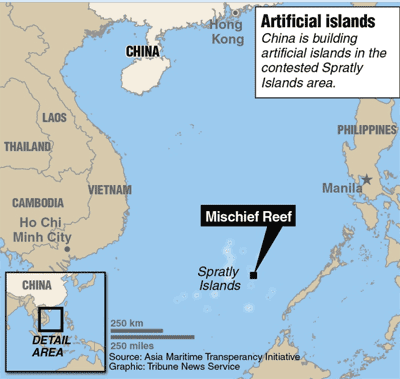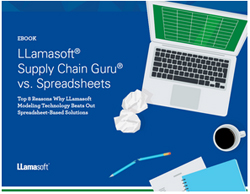 |
October 23, 2015 - Supply Chain Flagship Newsletter |
 |
| FEATURED SPONSOR: LLAMASOFT |
||
 |
||
Download this Ebook to learn the top eight reasons supply chain analysts say they prefer supply chain modeling software to spreadsheet-based solutions |
 |
|
||||||||||||||||||||||||||||||||||||||||||||||||||||||||||||||||||||||||||||||||||||||||||||||||||
But I digress. The first of those would be something called the Spratly Islands in the South China Sea. The second would be the unusual concept of an artificial island, created out of sand in the middle of the ocean. And China, of course, is at the center of both controversies. China is claiming ownership of the Spratly Islands, a collection of small landforms that as the map below shows are far, far from the Chinese mainland. Vietnam and The Philippines naturally dispute these claims, but lack of course the military might to defend their rights.
By what logic China should claim ownership of these islands I have no idea, but that is what has happened over the last few years. But it gets worse. China has also claimed ownership of seven small rock formations in the same area, around each of which it has now constructed artificial islands, bringing in mountains of sand to create 3000 acres of territory, to which it is adding ports, airstrips, military type facilities and more. The theory seems to be: Why battle the claims out for years in international courts, when we can just build and occupy the fake new islands and claim a fait accompli. Why would China want to do this? Part of it is just China's ever present drive to assert what it sees as its historical rights, but it is also no doubt a strategic play too. First, building up a strong naval presence there would certainly give China a powerful position to assert its authority or use its military should real conflict breakout in the region. |
|||||||||||||||||||||||||||||||||||||||||||||||||||||||||||||||||||||||||||||||||||||||||||||||||||
 |
|||||||||||||||||||||||||||||||||||||||||||||||||||||||||||||||||||||||||||||||||||||||||||||||||||
It would also potentially give China commercial control of sea lanes for the busiest area of container ship traffic in the world. Would China start using that control to charge foreign vessels for using its territory? China could also claim to control the airspace smack dab in the middle of the South China Sea? Thanks to Jeff Smith of The Diplomat, I learned that the UN Convention on the Law of the Sea (UNCLOS) does not prohibit land reclamation such as China is pursuing, but Article 60 bars states from claiming expanded rights for artificial islands built atop what were previously just rocks and low-tide elevations. Rather than the expansive 12-nautical mile territorial sea and 200 nm exclusive economic zone granted to "natural" islands, UNCLOS stipulates that artificial islands are only entitled to the rights enjoyed by the original feature before land reclamation, which isn't much. While China has not explicitly stated what it believes its rights would be, other statements seem to make it clear it would not recognize the limited UN rights cited above. Tensions are escalating rapidly, and we could have an incident between the US and China in just a few weeks, if not days. As China proceeded with its island building efforts, many US analysts began to call for "Freedom of Navigation Operations" (FONOPS) around the artificial islands. The FONOP program, in operation since 1979, involves sailing and flying ships and planes through waters and airspace to challenge (and make clear America does not recognize) illegal or excessive territorial claims. China, to put it mildly, is not in favor of that program. US Defense Secretary Ashton Carter has repeatedly asserted that the US military "will fly, sail, and operate wherever international law allows." Yet still no FONOPS have yet been ordered - while China's rhetoric has grown more confrontational. The same day, Admiral Yang Yi warned the China would deliver a "head-on blow" to any foreign forces "violating" China's sovereignty. There have been many more similar warnings and declarations. But that of course would further escalate tensions, and lead to months/years of the same scenario repeating itself, which seems likely to inevitably lead to number 3 in the end. Or does America just decide to complain but do nothing provocative? What happens upon option 3? I have no idea. Perhaps a smallish skirmish leads to some form of diplomatic talks where a resolution is eventually reached. But my guess China will never be willing to give up its claims, though it might agree to allow navigation of its water and air space. For now. All this, BTW, in the context of the just finalized Trans-Pacific Partnership free trade agreement between the US and 11 other Asian nations, one that notably left China out of the mix. China initially strong opposed the pact, but has been more positive about it lately. On another bit of cheery news, UK's The
Telegraph reported this week that Russia is collapsing economically, and may soon be out of its oil money reserves. What will a cornered Putin do then? Not pleasant to think about either, though with fewer supply chain implications, I think, though getting the price of oil back up is Russia's only path out of its misery. There are supply chain risks, and there are supply chain risks. The China island dispute is of a class we haven't seen in a long time. |
|||||||||||||||||||||||||||||||||||||||||||||||||||||||||||||||||||||||||||||||||||||||||||||||||||
|
|||||||||||||||||||||||||||||||||||||||||||||||||||||||||||||||||||||||||||||||||||||||||||||||||||
|
|||||||||||||||||||||||||||||||||||||||||||||||||||||||||||||||||||||||||||||||||||||||||||||||||||
|
|
|
YOUR FEEDBACK
We received some decent feedback on both our daily video coverage of CSCMP 2015 and our request for ideas to improve the conference. You will find a selection below.
Feedback of the Week on SCDigest's CSCMP Coverage
I am a proponent of conferences like these for many reasons. I think it is short sighted to rule them out as being frivolous, or just a vacation. Alas, I wasn’t able to attend this one mostly because I am Canadian, which means expensive long distance travel, and a 30% currency conversion on top. Sadly that makes one of the best available conferences also the most expensive. That being said, I just want to thank Dan and SCD for the daily video highlights and subsequent print articles. I watched them the minute they arrived and will read everything I can about the conference and its content. Great job on coverage for those of us who are interested. Steve Hogg, P.Log. CCLP |
||
| More on CSCMP Coverage | ||
I don't know how Dan gets it done, but these daily video summaries are excellent!
Keep it up! Dawn Herring
|
||
| Feedback on Ideas to Improve CSCMP Conference | ||
I think the conference was great with respect to structure, organization, logistics. |
||
My feedback on CSCMP:
- To bringing in more people: Name withheld by request |
||
SUPPLY CHAIN TRIVIA ANSWER
Q: What did Gillette, Hewlett-Packard, Johnson & Johnson, Kimberly-Clark, Kraft Foods, Nestlé Purina PetCare, Procter & Gamble, and Unilever, have in supply chain common in 2004?
A: They were the 8 original Walmart vendors involved in the first RFID pilot, sending tagged cases and pallets of product with EPC tags to a single distribution center in Sanger, TX. Things largely went downhill from there.
| © SupplyChainDigest™ 2003-2015. All Rights Reserved. SupplyChainDigest PO Box 714 Springboro, Ohio 45066 |
POWERED BY: XDIMENSION
|








